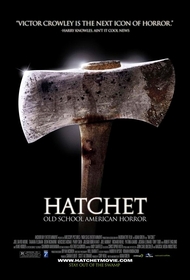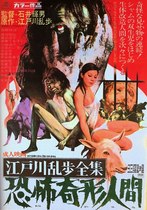Our editor-in-chief Nate Yapp is proud to have contributed to the new book Hidden Horror: A Celebration of 101 Underrated and Overlooked Fright Flicks, edited by Aaron Christensen. Another contributors include Anthony Timpone, B.J. Colangelo, Dave Alexander, Classic-Horror.com's own Robert C. Ring and John W. Bowen. Pick up a copy today from Amazon.com!
Hatchet (2006)
Before writer-director Adam Green's Hatchet, I couldn't tell you the last time I walked out of a slasher movie smiling like an idiot, or when I last said, "That is so cool!" during an expertly realized gore scene. I have never wanted to hug a director before, but I want to give Green a big bear hug now. Plainly stated, seeing Hatchet was the most fun I’d had with a slasher flick in a long time.
Critically, of course, "fun" is hard to quantify. You can go on the world's biggest roller coaster and then go gibbering to your friends about the time where "the coaster went around this freaky bend" and then "it went upside down twice," and come off sounding like a complete spaz. You're describing the motions and not the experience, the plot of your ride and not the joy.
Still, I suppose a description of the plot is necessary, as it is the container for the joy. So here it goes: a group of Mardi Gras tourists on a haunted swamp tour become stranded in the stomping grounds of Victor Crowley (Kane Hodder), the murderous phantom of a deformed boy killed in a prank-gone-wrong years ago. Well, that’s what happens in Hatchet, but it’s not what Hatchet is about. It's no more about a haunted swamp tour than Friday the 13th is about summer camp or Halloween is about babysitters. As with most good slasher movies, the plot is a means to an end -- the end of the characters' lives in the most creative ways possible.
Adam Green takes decades worth of slasher movies, weeds out the impurities, and comes out with a near-perfect realization of an old formula. Nothing he does is wholly original, but most of what he does is right. Green uses his knowledge of the horror genre to put together a clever film that is aware of the pratfalls of slashers past, somewhat (but not exactly) like Scream or Behind the Mask: The Rise of Leslie Vernon. Green’s trick, however, is to use his expert awareness of slasher tropes to his own advantage, rather than the advantage of his characters.
For instance, Green's use of Louisiana's bayous as a location is inspired, because it effectively isolates the characters and neatly sidesteps many of the common-sense complaints that plague other slasher movies. The characters can't just leave, because they're stranded miles from any sign of civilization, stuck in a part of the swamp that's illegal to be in. They can't call 911 because there's no cell phone signal. They can't just swim away because the water is full of gators who smell blood in the water and want more. Additionally, the heavily wooded, endless swamp feels both open, providing hope that the characters might escape, and closed, enveloping events with a sense of claustrophobia and despair. It's a dichotomy that Green pulls off well.
Another reason Hatchet works is because we're given characters who we want to survive. The film is partially a comedy and the people in it, with a few exceptions, are comic creations. While poor work on the part of the writer or the actors can cause this approach to backfire, Green and his cast are at the top of their game and the comedy works. The actors are almost all experienced comedians and the fact that they are funny (instead of merely attempting to be funny) endears them to us quickly. Richmond and McNab, in particular, stand out as the wisecracker and the perpetual ditz, respectively. The test of a good slasher character is whether you enjoy him or her enough to spend a whole movie with them where they do not die. A character that passes that test is one whose continued survival you can take an interest in, which allows the director to generate suspense by putting them in peril as well as emotion when he does, in fact, off them. I’m happy to report that there’s not a character in Hatchet’s main cast who doesn’t pass this test.
Hatchet is one of the more violent, gory slasher films in a long time. Green, along with makeup guru John Carl Buechler, provide us with some stunning death scenes. During one scene in particular, I found myself including spontaneously exclaiming, "That is so cool." While I won't spoil any of the particulars for you (I'm not even sure I could accurately describe it), I will say that it was perfectly over-the-top - everything I ever wanted from a ridiculous murder committed with the bare hands. The same can be said for most of the other murders, except with “bare hands" replaced with the name of the implement used where appropriate.
Interestingly, Green gives us the most technically complicated deaths earlier in the film; they get less and less intricate the further we go in. This could have been a fatal mistake, a case of "blowing his load" prematurely, but Green understands that there are actually two points to really awesome kills: the sheer spectacle and the establishment of Victor Crowley as a credible threat. Once Crowley is so established, there's no need to dwell on the details; we know what he can do and our concern is for the survivors. To provide a setpiece slaughter late in the film would've been to bring the breakneck pace to a screeching halt. Green proves that he's too smart for that.
It certainly helps that, as threats go, Victor Crowley is as credible as they come. Kane Hodder (of Friday the 13th Parts 7-10 fame), working under what must be pounds of latex, becomes a monstrosity of mythic proportions. When Crowley is off-screen, crying out in anguish and loneliness for his daddy, the sound pervades the screen from all sides and the melancholy echoes somehow make Crowley more terrifying. Plus, Hodder brings some old-school tricks learned in his long association with the slasher genre -- the best way to pop up out of nowhere, how to scream with enough rage to petrify the nerves, and pursuit strategies that make your prey think that you're slower than you really are. Certainly, some of this can be attributed to Green's brilliant direction, but Hodder so completely embodies Crowley that the brain rejects the notion that his effectiveness is due to anything but Hodder's performance.
Hatchet is not without its flaws, however. Adam Green's inexperience means that a few shots in the film come off as plain or undercooked. This is particularly true in his opening, an unsuspenseful and unengaging sequence featuring Robert Englund and Blair Witch’s Joshua Leonard. One of the few acting missteps is made by Tamara Feldman, who has to hold up one of the few dramatic performances in the film, all the while convincing us she’s a Louisiana local. She succeeds in the former, but fails in the latter, with her accent doing lazy circles around an actual Southern twang.
Perhaps most disappointing is the moment when Crowley wields a gas-powered belt sander as a weapon. In Classic-Horror's interview with Green, the director described how he almost didn’t film the sequence, because it was just too ridiculous. He put it back in when his production designer was able to construct a functional gas-powered sander. Maybe Green should’ve stuck with his gut instinct. The sudden appearance of the sander feels unreal, even in a film this gleefully silly. Crowley uses simple implements or his bare hands for everything else, so why does he suddenly have a functional power tool? Don’t get me wrong – the gore aftermath that results is one of the more grisly makeup effects in the film, but the sequence just doesn't fit.
Nitpicking aside, however, Hatchet is a refreshing experience. Unpretentious and smart enough to be dumb, it's a primer in how movies can be plain, adrenaline-soaked fun. Adam Green is a director to keep an eye on. I know I'll be watching, especially if he comes out with Hatchet 2.









This movie is for gore
This movie is for gore hounds. The horror, the horror. Ugh.